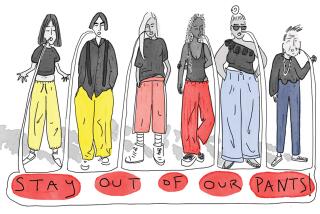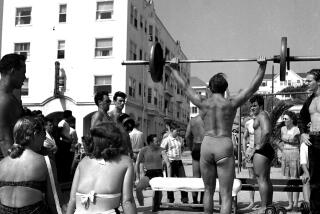Living Up to Thigh Standards
- Share via
The first lady’s thighs put people in a dither last week.
Newspaper photographs showed Hillary Rodham Clinton in a blue bathing suit, embracing hubby Bill while vacationing in the Virgin Islands. A photograph published earlier in the week had captured her in her bathing suit walking toward the water.
At breakfast tables, social gatherings and on talk radio, people discussed whether the photos had been staged to rehabilitate the president’s Paula Jones-damaged image. In collective horror, many women said no way! No way would any sane woman knowingly parade her sturdy thighs and backside to a camera lens. “Stand by your man, honey,” the sentiment seemed to run, “but never in a bathing suit.”
“I would never show my thunder thighs,” one woman caller gasped during a talk show. (The White House denied that the photos were staged.)
“I tried to make it a political discussion,” says KABC-AM radio (790) talk show host Ronn Owens, who says he believes Hillary Clinton participated knowingly in a photo op. “But all they could talk about was butt and thighs.” Bill’s marshmallow flesh drew no nasty remarks, however.
The images of the first lady’s thighs appear to have tapped into women’s obsessions and anxieties about their own bodies. Body image is fundamental to the way people experience themselves and the development of their concept of self, but the sexes differ markedly in their perceptions and attitudes toward their own bodies and those of the opposite sex.
In a study of roughly 1,300 subjects ranging in age from 8 to 80, Colleen S.W. Rand, a research psychologist at the University of Florida at Gainesville, found that more than 80% of the women said they wished they were thinner. They reported the most dissatisfaction with their thighs, butt, hips and stomach.
Only about 60% of men said they were unhappy with their bodies, with half longing for a more bulky, muscle-bound body, the other half for a smaller one.
“Men are not pleased with a pot belly, young boys want to be bigger and teenagers want to be more muscular,” Rand says.
Some men exaggerate the ways others perceive their bodies positively, according to an earlier study conducted by University of Pennsylvania researchers on college-age men. College-age women in the study distorted their body perceptions negatively. Still, despite some men’s dissatisfaction with their bodies, it is as the saying goes: It’s OK to be fat if you’re a banker, but not if you’re the banker’s wife.
“Women don’t expect men to put so much energy into their bodies,” says John Gray, author of “Men Are From Mars, Women Are From Venus” (HarperCollins, 1992). Cash flow makes a much bigger impression, transforming a guy like Bill Gates from Nerdman to Stone Fox.
“As Zsa Zsa Gabor said, ‘No rich man is ugly,’ ” notes Chris Kilmartin, a psychology professor at Mary Washington University in Fredricksburg, Va., and author of “Masculine Self” (Prentice Hall, 1994).
“For women, appearance is still the currency in a meat market,” says Rand, adding that even older women in secure marriages are unhappy with their bodies. “It is how women are evaluated by both women and men. What a man does for a living is still more central to his self-concept.”
Women weigh themselves more often than men do. They diet more. More of them have eating disorders. In a study conducted in 1984, Rand found that the only women between the ages of 18 and 34 who were satisfied with their weights were those 10 to 14 pounds under the lower weight limit recommended in national height-weight tables. Older women content with their weight were those in the lowest limit.
“I think what happens is women look at themselves and compare themselves to what television and advertising say is the ideal body,” Rand says.
But there is a reality gap for both sexes. In a study in which both were asked to select the most attractive body size from a series of drawn female figures, men and women chose the perfectly average size. And when Rand asked women to select the most attractive model in fashion photographs, they selected models in an ad for Lane Bryant--a store that caters to larger women but uses models who look like ordinary women, as opposed to the starvation-thin variety.
Why the disparity between what women say would be an attractive weight for their own bodies, and an attractive weight for other women? Helen Fisher, an anthropologist at Rutgers University, says Homo sapiens innately are drawn to the body type most likely to bear healthy young. “Average spells a good reproductive bet,” she says. “When the body veers too far from that, either too thin or too fat, people find it unattractive for evolutionary reasons.”
But the sexes are wildly confused about what each other wants in a physique, exaggerating whatever qualities they think the opposite sex finds alluring. Studies show that women generally think men like them thinner than men really do and that men think women like them more muscular than women actually do.
Furthermore, “men are obsessed with their crotches,” says Kilmartin. “Bulging crotches, bulging biceps, bulging wallets.”
In any case, photographs like the one of Hillary Clinton, says Pepper Schwartz, a sociologist at the University of Washington, are like all photographs--generally less kind than real life. Every woman who has a pathological fear of the camera understands, in a sickeningly visceral way, what a bad photo feels like. A bad photo in a bathing suit? Well, that’s grounds for changing your name and relocating to a small town in North Dakota.
“Most women over 25 consider a photo like the one of Hillary a nightmare,” Schwartz says. “Even my 13-year-old, who looks good in a bathing suit, would rather eat glass than see a photo of herself in one. I mean you can pillory [Hillary], you can indict her, you can do anything you like, but don’t photograph her thighs. It was mean to photograph her like that. Politics are dirty, but this is low.
“I think this is a Republican plot.”
More to Read
Sign up for Essential California
The most important California stories and recommendations in your inbox every morning.
You may occasionally receive promotional content from the Los Angeles Times.













